Protective reflexes - Study guides, Class notes & Summaries
Looking for the best study guides, study notes and summaries about Protective reflexes? On this page you'll find 2287 study documents about Protective reflexes.
Page 2 out of 2.287 results
Sort by
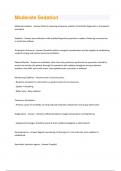
-
Moderate Sedation Questions With 100% Solved Solutions!!
- Exam (elaborations) • 12 pages • 2024
- Available in package deal
-
- $7.99
- + learn more
Moderate sedation - Answer-Patients requiring temporary sedation to facilitate diagnostic or therapeutic procedure Sedation - Answer-any medication with sedative/hypnotic properties is capble of altering conciousness or protective reflexes Training for Personnel - Answer-Should be able to recognize complications and be capable of establishing a patient airway and positive pressure ventilation Patient Monitor - Answer-an individual, other than the practiioner performin the procedure should ...
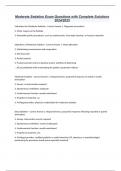
-
Moderate Sedation Exam Questions with Complete Solutions 2024/2025
- Exam (elaborations) • 6 pages • 2024
- Available in package deal
-
- $9.99
- + learn more
Moderate Sedation Exam Questions with Complete Solutions 2024/2025 Indications for Moderate Sedation - Correct Answer 1. Diagnostic procedures 2. Minor surgery at the bedside 3. Potentially painful procedures, such as cardioversion, chest tube insertion, or fracture reduction Objectives of Moderate Sedation - Correct Answer 1. Mood alteration 2. Maintaining consciousness and cooperation 3. Decrease pain 4. Partial amnesia 5. Prompt and safe return to baseline and/or activities of daily...

-
Moderate Sedation Certification Exam Questions and 100% Solutions| A+ Rated
- Exam (elaborations) • 48 pages • 2024
-
- $12.49
- + learn more
Moderate "Conscious" Sedation - A minimally depressed level of consciousness induced by the administration of pharmacologic agents in which the patient retains continuous and independent ability to maintain protective reflexes and a patent airway and to be aroused by physical or verbal stimulation. Levels of Sedation Analgesia - 1. Minimal Sedation 2. Moderate Sedation/Analgesia 3. Deep Sedation/Analgesia 4. General Anesthesia Minimal Sedation - 1. Patient is able to respond normally t...

-
Peds Exam 1 Questions And Answers
- Exam (elaborations) • 18 pages • 2024
-
- $10.89
- + learn more
Peds Exam 1 Questions And Answers Primitive Reflexes - ANSWER Typically present at birth; involuntary; affect posture and movement; integrated as CNS matures (suck, root, plantar, etc.) Automatic/Postural Reflexes: - ANSWER Evolve during the first two years of life; includes righting, protective, and equilibrium responses (head righting, protective extension) Protective Reflexes: - ANSWER Present at birth and persist through life; designed for protection/survival (blink...
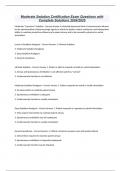
-
Moderate Sedation Certification Exam Questions with Complete Solutions 2024/2025
- Exam (elaborations) • 45 pages • 2024
- Available in package deal
-
- $10.99
- + learn more
Moderate Sedation Certification Exam Questions with Complete Solutions 2024/2025 Moderate "Conscious" Sedation - Correct Answer A minimally depressed level of consciousness induced by the administration of pharmacologic agents in which the patient retains continuous and independent ability to maintain protective reflexes and a patent airway and to be aroused by physical or verbal stimulation. Levels of Sedation Analgesia - Correct Answer 1. Minimal Sedation 2. Moderate Sedation/Analgesia ...
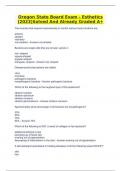
-
Oregon State Board Exam - Esthetics (2023)Solved And Already Graded A+
- Exam (elaborations) • 30 pages • 2023
-
- $17.99
- 3x sold
- + learn more
Oregon State Board Exam - Esthetics (2023)Solved And Already Graded A+ Oregon State Board Exam - Esthetics (2023)Solved And Already Graded A+ The muscles that respond automatically to control various body functions are: anterior striated voluntary non-striated - Answer non-striated Bacteria are single cells that are circular, spiral or: rod- shaped square-shaped angular-shaped triangular- shaped - Answer rod- shaped Disease-producing bacteria are called: virus microbes ...
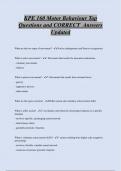
-
KPE 160 Motor Behaviour Top Questions and CORRECT Answers Updated
- Exam (elaborations) • 35 pages • 2024
-
- $8.49
- + learn more
What are the two types of movement? - Active (endogenous) and Passive (exogenous) What is active movement? - - Movement that results fro muscular contractions - voluntary movements - reflexes What is passive movement? - - Movement that results from external forces - gravity - supportive devices - other bodies What are the types of action? - Reflex action and voluntary action (motor skill) What is reflex action? - - involuntary and relatively stereotyped response to a specific stimulus...

-
Nitrous Oxide/Oxygen Sedation
- Exam (elaborations) • 7 pages • 2024
-
- $9.49
- + learn more
Nitrous Oxide/Oxygen Sedation sedation - ANS -the act of calming -a state of calmness conscious sedation - ANS -patient is aware of surroundings and conditions without feeling pain or anxiety -nitrous oxide/oxygen sedation -maintain airway -ability to respond physically and verbally -MINIMALLY depressed level of consciousness -INTRODUCED TO DENTISTRY IN 1950'S unconscious sedation - ANS -used more in hospital setting -put under minimal sedation - ANS -normal resp...

-
Moderate Sedation Certification Exam Questions And Actual Answers 2024.
- Exam (elaborations) • 44 pages • 2024
-
Available in package deal
-
- $9.99
- + learn more
Moderate "Conscious" Sedation - Answer A minimally depressed level of consciousness induced by the administration of pharmacologic agents in which the patient retains continuous and independent ability to maintain protective reflexes and a patent airway and to be aroused by physical or verbal stimulation. Levels of Sedation Analgesia - Answer 1. Minimal Sedation 2. Moderate Sedation/Analgesia 3. Deep Sedation/Analgesia 4. General Anesthesia Minimal Sedation - Answer 1. Patient i...
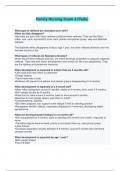
-
NSG 222 Family Nursing Exam 4 (Peds) - Questions and Answers
- Exam (elaborations) • 20 pages • 2024
- Available in package deal
-
- $20.49
- + learn more
NSG 222 Family Nursing Exam 4 (Peds) - Questions and Answers What type of reflexes are neonates born with? When do they disappear? Neonates are born with many reflexes called primitive reflexes. They are the Moro reflex, root, suck, asymmetric tonic neck, plantar and palmar grasp, step and Babinski reflexes. The Babinski reflex disappears at about age 1 year, the other reflexes diminish over the first few months of life What types of reflexes do Neonates develop? When the primitive reflexes di...

$6.50 for your textbook summary multiplied by 100 fellow students... Do the math: that's a lot of money! Don't be a thief of your own wallet and start uploading yours now. Discover all about earning on Stuvia


